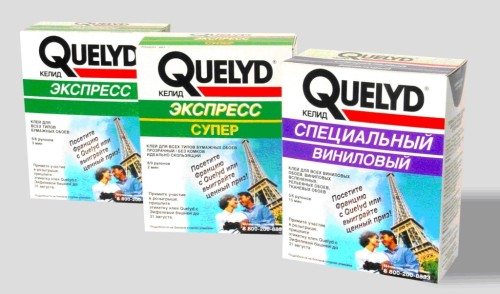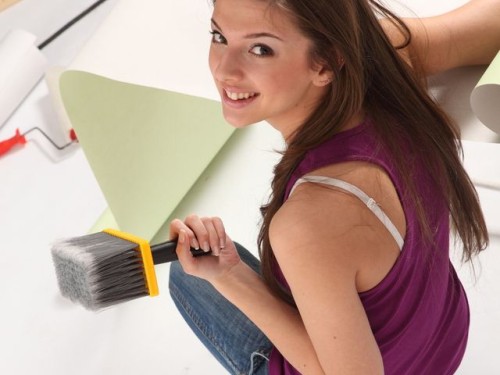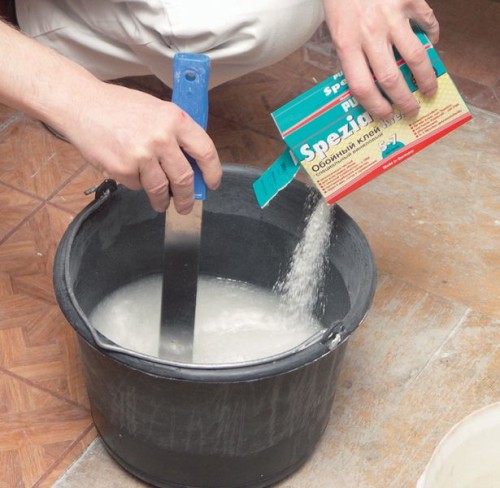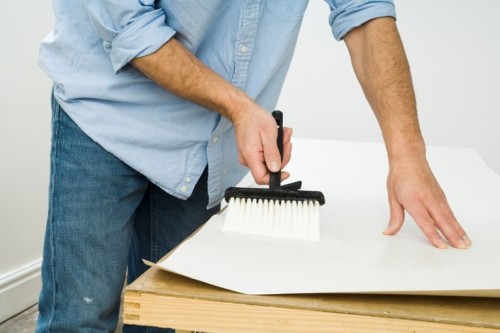
Wallpaper glue: characteristics, consumption and application Wallpaper
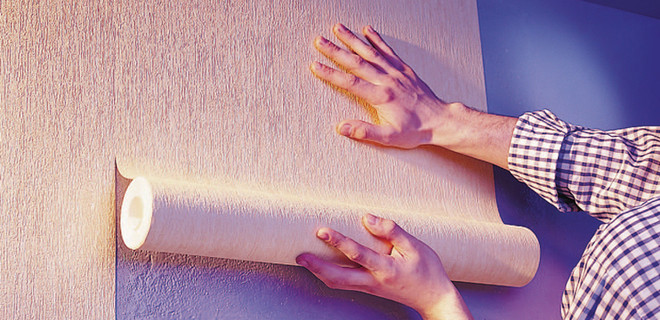
Wall finishing by wallpaper For many years now has been one of the most popular ways to decorate premises. There are many reasons for this, and the main of them are in the cheapness of the material, as well as in the wealth of its species, drawings, colors and textures. But not to spoil the finish, it is important to choose not only high-quality wallpaper, but also a suitable glue.
Content
The composition of the wallpaper glue
The main components of the wallpaper glue are substances:
- The base is the main component of the adhesive mass. To date, most manufacturers use methylcellulose or modified starch as the basis. The base is initially a dry powder, which, after dilution with water, turns into a viscous light translucent mass.
- Polyvinyl acetate is a component that is present in glues for vinyl wallpaper. This substance is non-toxic, almost does not smell and does not represent danger to health. But the polyvinyl acetate has excellent adhesive characteristics.
- Bactericides and fungicides are additives, the main goal of which is to prevent the appearance of mold and fungi on the sealed wall. These substances also protect the surface from insects.
Types of bulk glue
Classification of adhesives is based on the type of wallpaper for which such compositions are intended. Consider more, what products today offer manufacturers of such goods:
- A highly specialized adhesive for paper wallpaper is the cheapest, moreover, an outdated version, which is not so easy to find. This composition is not suitable for working with heavy types of materials and is intended solely for the simplest paper wallpaper. Many masters prefer to replace such glue by a more wide-profile universal composition.
- Vinyl wallpaper glue contains the above-mentioned polyvinyl acetate. Such a substance is used to work with severe vinyl wallpaper, since good adhesive properties of PVA allow the coating to securely hold onto the wall. For lighter types of finishing, the vinyl mixture is also suitable, but in such situations it is preferred not to use due to high cost.
- Universal wallpaper glue is characterized by an acceptable price, and its component composition includes substances intended for almost any type of wallpaper. Manufacturers are positioning such a product as a universal agent capable of equally well fix on the wall like light paper and heavy vinyl wallpapers. Such a statement should be considered with the share of skepticism, because completely universal building materials do not exist. Such glue will be perfectly cope with paper wallpaper, it is possible that the flieslinic coating it gluits quite firmly, which concerns vinyl wallpaper, then specially intended vinyl glue will be a more reliable option.
- Flizelin wallpaper glue, as follows from its name, is used in working with phlizelin wallpaper. For vinyl coating, such a composition will not fit, but with paper walls it will quite cope.
- There is also a special type of glue designed for glasses. This dispersion composition has increased strength and good performance characteristics. The price of such a wallpaper glue is quite high, but it can be used to finish the walls with textile coating. Note that it is possible to remove the wall with the walls, fixed with this glue, only special solvents.
Characteristics of the wallpaper glue
The quality composition for sticking wallpaper should have certain properties that we consider in detail:
- Ecology and harmlessness is the main requirement for the wallpaper glue. Since the type of wall cover under consideration is used for interior decoration, and most often for wall decoration in residential rooms, glue should not be isolated into the atmosphere of toxic substances. Fortunately, modern products are mostly manufactured from harmless components and is considered to be environmentally friendly.
- The glue must be disassembled well in water, forming a homogeneous mass without clots and lumps.
- The wallpaper glue does not dry too quickly and in a diluted form can be saved for several days if you close the capacitance with a lid and put it into the cool room.
- The above feature is good and the fact that the band passed on the wall can be shifted and moving over the surface for some time. This allows you to align the drawing, correct some defects, achieve the perfect result.
- Most wobble adhesives can be used as a primer for plastered walls, if subsequently, these walls are planned to be separated by wallpaper.
Before you buy wallpaper glue, you should familiarize yourself with its characteristics. What is worth paying attention to the purchase of material, consider further:
- The degree of adhesion of adhesive composition is a very important characteristic, since it depends on it how strong the wallpaper will hold onto the wall. This indicator is determined by the component composition of the mixture, in particular, the amount of polyvinyl acetate, if it comes to vinyl adhesive. Adhesion is two types: initial and final. Initial means the power of the clutch of the material with the wall at the time of touch. Final adhesion determines the degree of clutch of wallpaper with the surface after drying the adhesive. As a rule, such an indicator in the numerical designation is not contained on a pack with glue, but there will probably find information like this: "The composition has a high adhesive ability" or "slides well after contact with the wall." Methylcellulose is also characterized by the highest degree of adhesion, methyl cellulose is also characterized by methylcellulose, the modified starch has the lowest indicator.
- The second characteristic on which attention should be paid is the compatibility of the glue with the surface type on which wallpaper is planned. Many manufacturers indicate the goods packages such information. Often, the wallpaper glue is suitable for applying it on wooden, concrete, plastered, metal surfaces.
- When choosing glue, it is necessary to know the amount of fungicides, which are contained in the component composition of the substance. It is desirable that such additives were no more than 3%, since the excess of fungicides can adversely affect health.
- Acid-alkaline mixture is also important. The pH level should be equal to 6-7 units, then you can be sure that yellow spots will not come on the wallpaper.
- There is another useful characteristic - the moisture resistance of the glue. Such ability is useful if the wallpaper will be glued in too wet room, for example, in the bathroom or in the kitchen.
- The wallpaper glue should be non-toxic, environmentally friendly and not highlight an unpleasant odor.
Consumption of the wallpaper glue
Almost all manufacturers indicate an exemplary consumption of glue on its packaging, but such information is often not true. The fact is that, depending on the specific conditions of application, the consumption of substance may be much more or less than indicated in the instructions.
The type of wallpaper is an important point to take into account when the glue is diluted with water. The harder and dense material, the thick should be a glue composition. However, in such a situation you can reduce the consumption of substance, if you properly conduct preparatory work. Using 2 layers of primer instead of one, as well as the use of materials of one manufacturer will reduce glue consumption by about a third.
The surface structure taken by wallpaper also affects the cost of glue. Porous and rough materials will require more solutions than smooth and dense.
Consider the approximate consumption of glue on the example of vinyl wallpaper:
- If the surface must be preloaded, the dry mixture is divorced by water in the proportion of 1:40. This means that a standard bundle weighing 300 g must be dissolved in 12 liters of water. Such a number of glue will be enough to predict about 100 m² of walls.
- When sticking vinyl, textile or structural wallpapers, we need to make a thick enough mass. Standard 300 g of dry powder must be divorced in 6 liters of water, that is, in the proportion of 1:20. Thus, approximately 35-40 m² can be treated with such a number of glue.
- For thin paper wallpapers, adhesive may not be so thick, 300-gram pack can be divorced in 9 liters of water and coat with a composition from 45 to 50 m² of surface.
Application of wallpaper glue
Preparation of the surface and the preparation of adhesive composition
Before breeding wallpaper glue with water, you need to prepare the wall. This process consists of several stages:
- First of all, the surface should be cleaned from the old coating. Former wallpapers need to be twisted with water and remove the spatula, the tile can be knocked down, and the paint is removed using a solvent.
- After that, the purified walls are thoroughly align, close the slots and cracks by plaster, all the protrusions are knocked down and polished with sandpaper. Then the walls can be aligned with a putty and again cleaned with a fine-grained emery.
- The next stage is the primer of the walls. For this purpose, it is best to use the same glue to which wallpapers will later be glued.
- After drying, the primer can be processed to further actions: preparation of wallpaper bands and leakage of adhesive mass.
Wallpaper glue is bred by water in accordance with the instruction that is attached to the product. For the preparation of the solution, a deep enameled or plastic container is chosen and fill it with the desired amount of water. Water should be used cold, because in warm water glue can take rockets. In cold water, dry powder is suited with a thin weaving, constantly stirring the solution.
For high-quality glue stirring, it is convenient to use a building mixer or a special nozzle that is put on a drill. If there are no such tools at hand, the mass can be stirred by a wooden wand. The adhesive composition is convenient to prepare together: one person spits powder, the second - mixes the liquid.
After cooking, the glue should stand for 15 minutes to purchase the necessary properties. Then the mass should be mixed again, after which it will be ready for use.
Wallowing walls
If thin paper wallpaper is used to finish the room, glue should be applied only on the wall. If you still smear also paper, it can bust and break. When working with all other types of materials, glue is applied both on the wall and on the wallpaper.
The adhesive is more convenient to smear a wide flat brush or painting roller. It is very important that dry places are left on the surface to be processed. Many modern adhesive compositions after dissolution acquire a pink shade, which allows you to control the quality of their application. After drying, this color disappears.
When the wall is moistened with glue, you need to wait 5 minutes, and then begin to stick the wallpaper. To dry, heavy wallpapers may be needed to two days. While the coating dries on the wall, the room cannot operate the windows and allow even the slightest draft, otherwise the material will go back from the surface.





